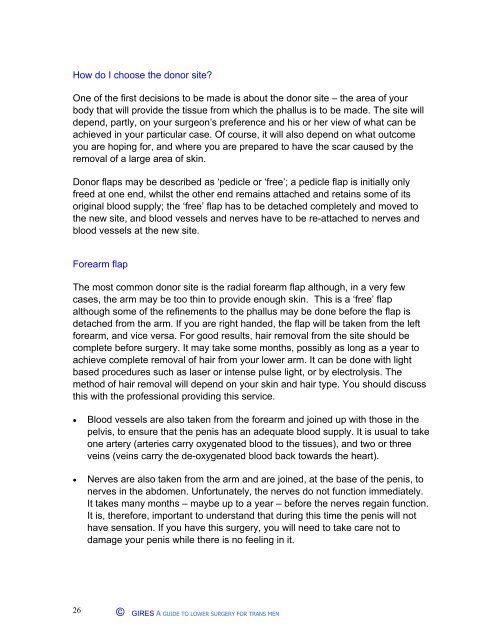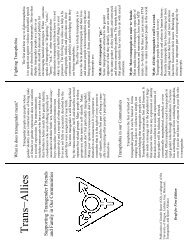A guide to lower surgery for trans men - Gender Identity Research ...
A guide to lower surgery for trans men - Gender Identity Research ...
A guide to lower surgery for trans men - Gender Identity Research ...
Create successful ePaper yourself
Turn your PDF publications into a flip-book with our unique Google optimized e-Paper software.
How do I choose the donor site?<br />
One of the first decisions <strong>to</strong> be made is about the donor site – the area of your<br />
body that will provide the tissue from which the phallus is <strong>to</strong> be made. The site will<br />
depend, partly, on your surgeon’s preference and his or her view of what can be<br />
achieved in your particular case. Of course, it will also depend on what outcome<br />
you are hoping <strong>for</strong>, and where you are prepared <strong>to</strong> have the scar caused by the<br />
removal of a large area of skin.<br />
Donor flaps may be described as ‘pedicle or ‘free’; a pedicle flap is initially only<br />
freed at one end, whilst the other end remains attached and retains some of its<br />
original blood supply; the ‘free’ flap has <strong>to</strong> be detached completely and moved <strong>to</strong><br />
the new site, and blood vessels and nerves have <strong>to</strong> be re-attached <strong>to</strong> nerves and<br />
blood vessels at the new site.<br />
Forearm flap<br />
The most common donor site is the radial <strong>for</strong>earm flap although, in a very few<br />
cases, the arm may be <strong>to</strong>o thin <strong>to</strong> provide enough skin. This is a ‘free’ flap<br />
although some of the refine<strong>men</strong>ts <strong>to</strong> the phallus may be done be<strong>for</strong>e the flap is<br />
detached from the arm. If you are right handed, the flap will be taken from the left<br />
<strong>for</strong>earm, and vice versa. For good results, hair removal from the site should be<br />
complete be<strong>for</strong>e <strong>surgery</strong>. It may take some months, possibly as long as a year <strong>to</strong><br />
achieve complete removal of hair from your <strong>lower</strong> arm. It can be done with light<br />
based procedures such as laser or intense pulse light, or by electrolysis. The<br />
method of hair removal will depend on your skin and hair type. You should discuss<br />
this with the professional providing this service.<br />
Blood vessels are also taken from the <strong>for</strong>earm and joined up with those in the<br />
pelvis, <strong>to</strong> ensure that the penis has an adequate blood supply. It is usual <strong>to</strong> take<br />
one artery (arteries carry oxygenated blood <strong>to</strong> the tissues), and two or three<br />
veins (veins carry the de-oxygenated blood back <strong>to</strong>wards the heart).<br />
Nerves are also taken from the arm and are joined, at the base of the penis, <strong>to</strong><br />
nerves in the abdo<strong>men</strong>. Un<strong>for</strong>tunately, the nerves do not function immediately.<br />
It takes many months – maybe up <strong>to</strong> a year – be<strong>for</strong>e the nerves regain function.<br />
It is, there<strong>for</strong>e, important <strong>to</strong> understand that during this time the penis will not<br />
have sensation. If you have this <strong>surgery</strong>, you will need <strong>to</strong> take care not <strong>to</strong><br />
damage your penis while there is no feeling in it.<br />
26<br />
© GIRES A GUIDE TO LOWER SURGERY FOR TRANS MEN
















